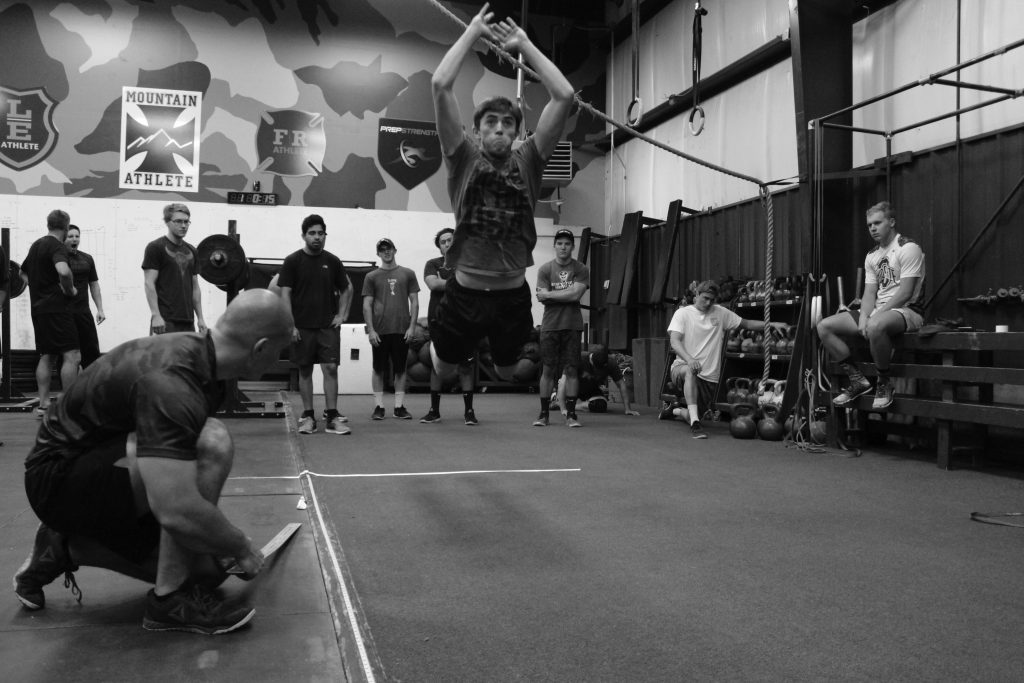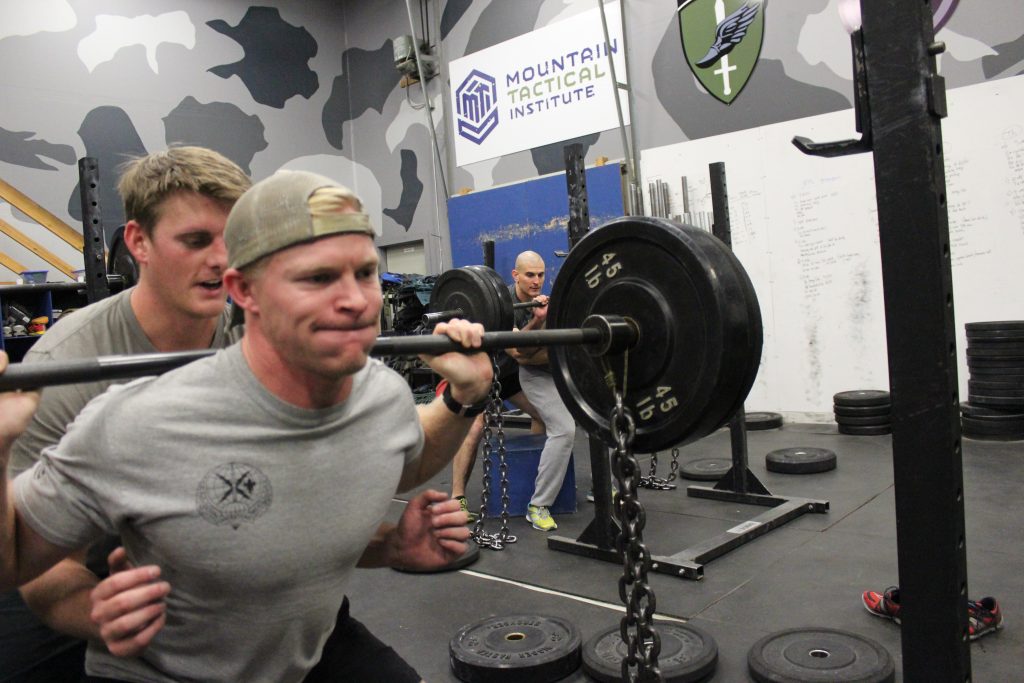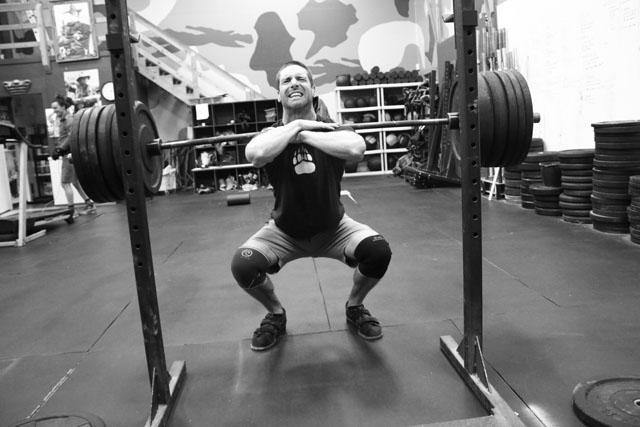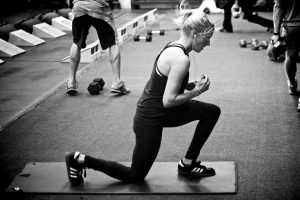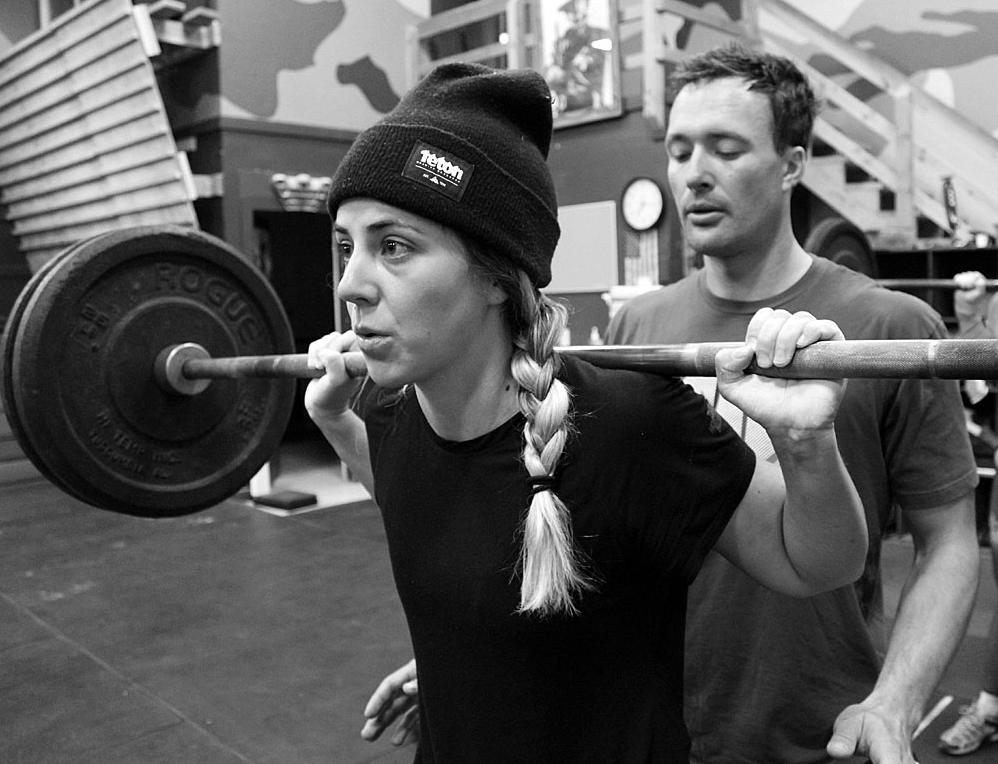QUESTION
I am 41 years old and a former college baseball athlete turned police officer turned tactical operator. I have subscribed to your training for many years. As a SWAT team operator I was in charge of the physical fitness program for our full time team here in NJ. In 2013, I received a pretty severe in the line of duty injury which ultimately required me to retire. In short I was shot in the stomach and run over causing a series of surgeries to my right leg, knee hip and stomach. I have had three knee surgeries repairing pretty much my entire right knee. The last surgery was botched leaving my knee pretty much un-repairable without a replacement knee (which I refuse to do at my age). I have followed your operator courses, your LE courses and most recently your fat loss program. I am currently 5’10” 210 lbs. my optimum weight for my body type is around 190. I know how diet and I have the discipline to do so. However, with the fat loss program I have found that my knee and cardiovascular endurance is not up to the challenge. As I am getting older my metabolism is slowing down even the my first is on point.
This is a very generic question based on the background I mentioned above but do you have any idea that could kick start my metabolism, burn fat while keeping some of my muscle tone? I’m normally a pretty muscular guy and my mind may be playing a little bit with me in so far as I can’t do the thing I used to be able to do. But any help would be much appreciated as my fat ass keeps getting fatter!
ANSWER
Nothing groundbreaking here:
1) Try unloaded endurance/work cap modes which your knee can handle: cycle/spin, swim, or row. Because body weight isn’t supported it will impact your knee less.
2) Get your Testosterone checked – low T can lead to belly fat.
3) Get a 2nd and 3rd and 4th opinion on your current knee. Not all doctors are created equal and it’s amazing how often two will look at the same issue and say completely different things. Some of the best knee doctors live in ski towns … these guys do a 1/2 dozen surgeries/day during the season.
4) Stop being stubborn and get your knee replaced. The technology is getting better all the time. If you haven’t already, do some research and talk to 3-4 other young people who’ve had the procedure.
5) End the “Cheat” day in our dietary recommendations – and/or try the Whole 30 Diet.
I did and liked it – It’s pretty much our recommendations minus the cheat day. It does make you realize how sugar is in everything …. ketchup, etc.
– Rob
QUESTION
I’m planning on using your SFOD-D selection packet before I assess but I’m not sure how far out I am from my date. Could be 12 months or 18 months. Should I start with operator programming or just jump right in and hold off in the final prep and taper till I’m 10 weeks out?
ANSWER
If you go in 12 months you’ll be set. If you go in 18 months, I’d still complete the full packet, then drop into the Greek Hero Series plans for 2 months, then repeat the final 10-week plan directly before selection.
– Rob
QUESTION
I have competing fitness demands and I am hoping you can recommend a plan. I am a LEO on the department’s part time SWAT team that trains bi-monthly. I am also in a National Guard infantry unit with has long rucks and patrolling during our drill days. We have a deployment coming in a little less than a year. To compound this I have been flirting with the idea of attending SFRE in a few months. I am trying to find something to help round me out for all of these things. Any advice? I appreciate any help I can get.
ANSWER
We have focused training plans and packets for LE Patrol/Detective, LE SWAT/SRT, and Military. If you weren’t thinking about SFRE, I have you do our LE Patrol/Detective Training – specifically the plans in the Spirits Packet. But with SFRE looming that programming wouldn’t build the military endurance (running/rucking) you’ll need at SFRE. So I’d recommend you complete the plans in the
Greek Hero packet for Military Athletes. These plans concurrently train strength, work capacity, chassis integrity (core), tactical agility and endurance (running/rucking).
– Rob
FOLLOW UP
How are the Greek and Virtue plans different? I have heard a lot of good things about Humility as well.
ANSWER
1. The training plans in both series were both initially completed by our tactical lab rats, including myself, at our facility in Wyoming. The Greek Hero Series deploys our most recent programming. The Virtue Series deploys our previous version.
2. Both Series are designed as day to day programming for tactical athletes. The Virtue Series concurrently trains strength, work capacity, endurance and chassis integrity. The Greek Hero Series trains these attributes plus TAC SEPA (tactical speed, explosive power, and agility).
3. Each plan in the Virtue Series trains these attributes concurrently, but each also emphasizes certain attributes. Fortitude, for example, emphasizes gym-based strength and moderate paced mid distance endurance. Some of the Greek Hero plans likewise have areas of emphasis, but it is more subtle.
The more defined emphasis in the Virtue Series allows me to target these plans to athletes relatively new to our programming, or who need to work on specific areas.
In general, the Virtue programming is simpler, more direct and more “jagged.”
As tools, I can deploy for athletes the Virtue plans are a little blunter. The Greek Hero plans are more fluid, subtle and sophisticated.
The Virtue Plans make a great foundation for the Greek Hero plans.
– Rob
QUESTION
I am currently using the SF 45 Alpha training plan and find it to be exactly what I was looking for as a multi-sport outdoor athlete.
The sandbag and posterior chain work seem to engage the core muscles.
Should I supplement with any additional core work?
ANSWER
The Chassis Integrity circuits in SF45 deploy our current answer for functional, transferable mid-section strength and strength endurance training for mountain and tactical athletes. Read more on the theory behind Chassis Integrity
HERE.
More core work? No.
– Rob
QUESTION
Thanks for all the great training programs you guys develop. Wish I lived closer to your facility, and I’d stop by to get my ass kicked!
Here’s the question I have…
I’m 40 years old and about to retire from 20 years of active duty Navy service. I’m in great shape, but beat up from years of barbell work, AND I have a recently diagnosed fracture (birth defect apparently) between L1 and L2 on my spine. Deadlifts and weighted squats are out because they agrivate that injury…and it’s bad.
All that being said, I’d like to find a bodyweight program that allows me to maintain my current level of size and muscle mass, and work down to 5-7% bodyfat. I’m sitting around 10-12% bodyfat now, at 6’2″ and 191 lbs. I don’t usually run long distance… anything more than 3 miles because I’m not training for or expecting endurance improvements at this point.
As much as I like bodyweight training, I historically lose muscle mass when that’s what I focus my training on, even when my diet is on point.
Now that I regurgitated all that, do you have any thoughts?
Thanks,
LT Ryan Mausolf
ANSWER
Hypertrophy (mass building) demands set/rep schemes in the 10-15 rep range per set. The athlete will adjust the loading on the bar/dumbbells to hit this range – with a “hard but doable” effort.
The issue with bodyweight only work is for most exercises, and most athletes, this rep range is too easy. And, going higher reps, i.e. 20-50 or whatever, stops training hypertrophy and starts training strength endurance. You won’t add mass.
So somehow you’ll need to “scale” bodyweight exercises by increasing their difficulty back down to the hypertrophy 10-15 rep range.
For upper body pressing movements (push ups) you can do this by elevating your feet – i.e. handstand push ups, using rings (ring push ups, ring dips) and loading (weight vest).
For upper body pulling movements (pull ups, chin ups, horizontal rows), you can do with loading (weight vest) and rings – muscle ups.
Lower body is tricky – I would an anecdotally that we’ve seen significantly lower mass gains via our Quadzilla Complex with the skiers and others who have used it for programming. Another option is to complete our Leg Blasters in a weight vest.
Is a weight vest allowed with your back? If so, I still wouldn’t push it past 25#.
5-6% Bodyfat? No training program alone will help you get here. I’d add that this low percentage is may not sustainable. You’ll have to get here with a very restrictive diet i.e. bodybuilding comp and fitness body comp stuff. I’d recommend you research pre-comp bodybuilding diets for insight. I’m assuming there will be a combo of caloric restriction and super low carbs at work. The caloric restriction is the non-sustainable part for most.
– Rob
QUESTION
I am a long time user of your programs. I am currently using you apft program for my troops remedial pt program and my plt just completed the six week body weight program which I think has helped keep my guys motivated since we are limited on equipment here in Poland.
If I was to start the Afghanistan pre deployment program would I still gain push-up and set-up strength? I don’t want to loose what these guys have worked hard to achieve.
Or what do you suggest to maximize gains with a limited amount of equipment.
ANSWER
Would your guys gain/maintain push up and sit up strength if they completed the
Afghanistan Pre-Deployment or another one of our training plans? It depends upon the fitness levels of the individual athletes. My guess is the unfit guys would continue to gain, but slower and the fit guys would maintain, or perhaps lose some.
But that’s the issue right? Traditional Army PT is APFT focused and ends up being push ups, sit ups, run, repeat for years on end.
Best is to use the APFT Training Plan the 6 weeks directly before the APFT, and then do more mission-direct programming in the spaces between.
For your guys in Poland, as a solid PT challenge, I’d recommend the
Urban Conflict Pre-Deployment Training Plan. This thing is no joke, will require some equipment and programming resourcefulness on your part, have perhaps a more mission-direct application and push everyone in your platoon
– Rob
QUESTION
I recently heard great things about your training and want to try it out for myself. You have so many plans though that I do not know where to start and would appreciate any help.
I am a sophomore in college and in Army ROTC. I want to become an Infantry Officer (1.5-ish years away) and way, way down the line, put in a packet to become an SF Officer (6-ish years). My APFT at the beginning of this year was a 249 with 61 PU, 61 SU, and 13:40 2-Mile. Obviously, I need to increase my PT score to the max (300) but I will not have another record PT-test until March. Until then I want to become the strongest and fastest I can be. I am 5’11 and 191 pounds, overweight -not from muscle. Any help selecting a plan and anything else would be greatly appreciated!
ANSWER
– Rob
QUESTION
Just a couple questions;
-dynamic warm-ups, is there a repository of these anywhere on the site,
specifically for lumbar, thoracic, core, etc?
-I’m restricted from doing barbell squats of deadlifts, prevents the
opportunities to lift heavy things, options that offer that level of
strength activation and growth?
Thanks for the great content and training plans.
ANSWER
Dynamic Warm Ups? No – and I sense your bigger questions concerns your back. You may want to look at our
Low Back Fitness Training Plan – it’s been a successful plan over the years to build back low back fitness. But even this plan includes gradually progressed lifting.
It’s not clear from your not if you’re restricted from all weight training – including dumbbells, sandbags, etc., – but it seems it might.
If that’s the case – I’d recommend you begin with our
Bodyweight Foundation Training Plan. This plan deploys an initial assessment and follow-on progressions based on your assessment results. In this way the plan automatically scales to your incoming fitness level.
An intense step up from Bodyweight Foundation, which deploys dumbbells, sandbags and loaded running (25# vest or IBA) is
Humility.
Look at these options and send back questions.
– Rob
QUESTION
I just purchased a subscription. I was hoping you could point me in the right direction for a training plan.
I have a 10 day backpacking trip coming up in January. And I spend most of my free time skiing and mountain biking. Also, hoping to train 3-4 days a week, with the other days devoted to skiing/mtb/etc. Is there a plan that you’d recommend?
ANSWER
I’d recommend you complete the Tuesday, Wednesday and Thursday sessions from the
Backpacking Pre-Season Training Plan. These training days will hit strength, uphill hiking under load (step ups) and rucking (movement under load).
– Rob
QUESTION
I am new to the site and was hoping you had a minute to point me in the right direction as there are so many programs from which to choose. I am ex-military, about to turn 50, and I’m looking to get on a regular plan that trains the fitness aspects your plans cover. I’m 6’2” and 2I5 lbs. I’m in decent cardiovascular shape, and don’t have any injuries to work around. I need to lose some fat, which I know is mostly diet, would like to work up to the MTI Relative Strength standards, and be able to run a sub 20 min 5K. I was going to start with the fat loss plan, but I thought that may be better saved as a focused program to lose that last bit of fat, if required. In my experience, the fat will come off with a good rounded program as long as diet is in check. Routes I was looking at include Rat 6, as I feel my relative strength needs the most work, followed by the Best Ager, Virtue, or Greek God series. What would you recommend as a solid way ahead plan? Thanks so much for your time.
ANSWER
Agree with a strength focused start. Rat 6 is solid.
After, drop into the Greek Hero series with Hector … see how you recover. I’m 49 and me and my other 40+ lab rats have moved to our SF45 Programming – which is easier on the joints.
If Hector is too much for your joints, switch to SF45 Alpha. The SF45 programming is awesome, but not quite as impactful to old guy’s joints. You could start there too.
QUESTION
Cadet at USAFA here. Vaguely following TACP plan with other battlefield airmen type workouts in between. Working on increasing lower body strength while increasing speed for 1.5 mile and 5k runs. Any recommended exercises that could accomplish this?
ANSWER
No dumbbells?
Leg Blasters … but start with Mini Leg Blasters.
Here’s a study comparing the effectiveness of Leg Blasters vs. Front Squats.
– Rob
QUESTION
Thank you for the great work you guys do. I have browsed some of your programs for a while and am now looking for some assistance with picking a workout package that best suits my goals.
I am a 23 year old male. On the civilian side, I currently work in a corporate atmosphere but am in the application process with multiple fire departments in hopes of changing careers. On the military side, I currently serve in an infantry National Guard unit and will be attending Mountain Warfare School next May. My goal in the next year or two (depending on things in the civilian side) is to attend SFRE, and if all goes well, SFAS.
Fortunately, it appears you have packages for all of these things (CPAT/Firefighter, Mountain Warfare, SFRE, SFAS/ruck-based selection). Unfortunately, I cannot purchase and simultaneously follow all of these great programs.
My question is … if there was only 1 (or 2) program(s) that you could recommend to best prepare for all of the above opportunities, which would it be? Please let me know if you would like any additional information.
ANSWER
This will kickstart your training, and lay a solid foundation for whatever is ahead as your plans/future shapes up.
– Rob
QUESTION
I’m an active duty soldier who was introduced to you guys thru another person in my unit as a possible place to help me get ready to train for and go thru 160th SOAR’s green platoon selection process. I saw training plans for Rangers and stuff and was wondering what you guys recommended for training for this. Any information and guidance I could receive would be very helpful. I look forward to your response.
ANSWER
Good luck!
– Rob
QUESTION
I’m a mountain guide and hotshot candidate out in CA. I am on week 3 session 2 of the Body Weight Foundation plan and am really enjoying it as well as seeing some pretty terrific results both physically and mentally. So I guess, first of all thanks for that!
I’m am however struggling with hand release push up and pull up numbers which have historically been my hardest movements. I did suffer an injury (rhabdomyolysis/right shoulder) in the navy and have never performed these movements the same since. I am an avid climber and have had little issue there, but for whatever reason I’m getting smoked after 25-30 push-ups and only 3-5 (inconsistent) pull-ups.
Granted, my overall fitness has been limited to a trekking/super mellow climbing routine before I started the plan, but is there any additional movements I can do to help improve my numbers with these movements?
I have seen an encouraging 18lb drop in weight, as well as a noticeably stronger core and cardio endurance but don’t seem to be improving in the areas I referenced earlier.
Thanks in advance for any and all advice you can lend regarding this!
ANSWER
Be patient and follow through with the rest of
Bodyweight Foundation. Email back on the other side with your Week 1, Week 3 and Week 6 (if I remember right) assessment numbers.
– Rob
QUESTION
For context, I’m a former Navy SWCC and a two-time cancer survivor. I’m looking to get back into peak fighting condition
My condition: I’m 6’2″, but less than 180 pounds, and less than 13 percent body fat. I’d love to get stronger and gain more fighting weight, but joint issues (especially in my elbows) prevent me from doing many pull-ups and chin-ups.
My home gym doesn’t have everything on your list. I’ve got dumbbells, kettlebells, sandbags, pull-up and dip bars, and rucks; I can probably improvise for some of the rest.
For what it’s worth, your
MTI diet video made a lot of sense to me. Do you offer more about diet?
ANSWER
You’ll need a rack/bench, bar and bumpers for the Greek Hero plans.
I’d recommend you start our stuff, assuming you’re pretty fit already, with
Humility, from the Virtue Series. This limited equipment plan will take you back to your Navy days minus the water.
More diet stuff? No. That’s the point of our approach … don’t make it any more complicated than it needs to be.
– Rob
QUESTION
I recently found out I have a small tear in my patellar tendon. Next week I am having a procedure done to fix it. It’s not surgery it’s an injection that will speed up the healing process apparently. I’ll be in a brace and will have to stay off of it for 2 weeks. After that I have rehab for 3 months. After I can get off my crutches and out of my brace would your “training program for athletes suffering leg injury ” be ideal for me? What do the work capacity circuits look Like? Because I won’t be cleared to run for at least 2 months.
ANSWER
I’ve had athletes do the
Leg Injury plan on crutches – it’s designed to work around your injured leg – including the work capacity efforts … i.e. no running.
-Rob
QUESTION
I am preparing for PRMC but have longer than 6 weeks. What other plans would you recommend before the PRMC plan? If you could choose just 1, or a series of 2, 3, 4?
ANSWER
– Rob
QUESTION
I have a quick question here. I just purchased the fortitude workout program, I just need some clarification on the “grind” portion of the workout. 15 vs 17 vs 20 min grind? why does the time intervals increase? Also the 3x Keg Lift with Sandbag @ 40/60# is it 3 60sec reps or only 3 reps total. Any help to clear this up would be appreciated just would like to perform the workout properly.
ANSWER
“Grind” = work steadily at a moderate pace. Don’t be frantic. Time intervals increase because we’ve found that athletes not used to this start slogging if we jump right to 20 min.
3x Keg Lift = 3x each side, 6x total.
– Rob
QUESTION
I am currently deployed with a lot of time on my hands to workout. I have used many of your programs in the past with great success. I used your pre-Ranger program in my train up to Ranger school and can happily say that I am now Ranger Qualified.
I am currently training up for Special Forces Assessment and Selection using the THOR-3 program. I have about 10 months before I go to Selection. I am also trying to improve strength (THOR-3 by itself isn’t getting me where I want to be, for reps and for power). I have trained using the Fortitude, Vertue, SFAS progression in the past, however, my location only allows me to run / ruck 3 days out of the week.
In your opinion, is it feasible to mix THOR-3 and Big 24? THOR-3 in the AM and big 24 in the PM? My concern is that limited rest time would actually reduce any potential strength gains/fitness gains. I am very accustomed to doing 2 a days, however the THOR-3 program is difficult to co-program with, as the strength days are typically whole body. Is there another program that you might recommend?
ANSWER
Best not to double up programming.
– Rob
QUESTION
I would love some help picking a new program, I am about to complete the Busy Operator program and I have loved it, I want to continue with a similar program and was looking through the various Operator plans but I am unsure which would be best. I would like to have a program that was similar but focused on strength gains while still keeping me running on occasion, not because I like it, but because I need it. Which of your Operator programs, or maybe a mix of programs, would you recommend?
ANSWER
Subscribe to MTI's Newsletter - BETA


